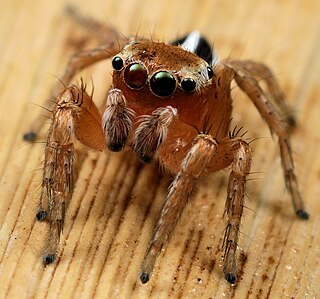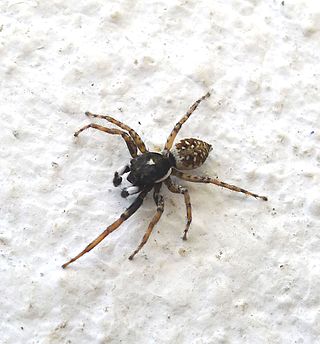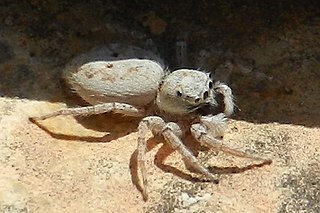
Zygoballus is a genus of jumping spiders found in North and South America.

Zygoballus sexpunctatus is a species of jumping spider which occurs in the southeastern United States where it can be found in a variety of grassy habitats. Adult spiders measure between 3 and 4.5 mm in length. The cephalothorax and abdomen are bronze to black in color, with reddish brown or yellowish legs. The male has distinctive enlarged chelicerae and front femora. Like many jumping spiders, Z. sexpunctatus males exhibit ritualized courtship and agonistic behavior.

Evarcha vittula is a species of jumping spider in the genus Evarcha that lives in South Africa. The species was first described in 2011 by Charles Haddad and Wanda Wesołowska. The spider is small, with a carapace measuring between 2.4 and 3.2 mm long and an abdomen between 2.5 and 3.6 mm long. There is a delicate scutum on the abdomen. The spider is generally dark brown but there is an orange streak down the middle of the upper surface of both the abdomen and carapace. This streak helps distinguish the spider from others in the genus. It can also be identified by its copulatory organs. The male has a characteristic short straight embolus. The female has not been described.

Evarcha flagellaris is a species of jumping spider in the genus Evarcha that lives in Kenya and South Africa. The species was first described in 2011 by Charles Haddad and Wanda Wesołowska. The spider is small, with a carapace measuring between 2.0 and 2.4 mm long and an abdomen between 1.9 and 3.6 mm long. The female is larger than the male, particularly in the size of its abdomen. Both have stripes on the abdomen, the male being more distinct with four brown stripes contrasting with a yellow background. This is similar to the related Evarcha striolata, from which it can be distinguished by the presence of an orange scutum. It can also be identified by its copulatory organs. The female has very wide looping insemination ducts that lead to heavily sclerotized multi-chambered spermathecae. The male has a long straight projection from its tibia or tibial apophysis and a whip-like embolus. It is after the latter feature that it is named.
Microbianor globosus is a species of jumping spider in the genus Microbianor that lives in South Africa. It lives on the banks of the Orange River in Northern Cape. The species was first described in 2011 by Charles Haddad and Wanda Wesołowska. It is a very small spider, with a carapace typically 1.1 mm (0.043 in) long and an abdomen typically 1.2 millimetres (0.047 in) long. The carapace is high, broad, short and almost completely dark brown. The abdomen is oval with a white pattern of patches around a central line. The front pair of legs are longer and brown, the remainder being yellow. The male has a characteristic long embolus that curves around the palpal bulb. There is an unusually large spike or apophysis on the pedipalp tibia. This helps identify the species. The female has not been described.

Evarcha acuta is a species of jumping spider in the genus Evarcha that lives in Namibia, Seychelles and South Africa. The species was first described in 2006 by Wanda Wesołowska. The spider is small, with a carapace measuring typically 1.6 mm (0.06 in) long and an abdomen between 1.4 and 1.9 mm long. The carapace is light brown with a short black eye field. The abdomen has patterns that vary depending on geography. The holotype, found near Brandberg Mountain in Namibia, has lines of brown patches on the top. Examples found in Free State, South Africa, have black lines on the top and sides. The spider can be most easily distinguished from other spiders in the genus by its copulatory organs. The male has a distinctive notch on a long straight projection from its tibia known as a tibial apophysis and a long embolus. The female has not been described.

Afraflacilla roberti is a species of jumping spider in the genus Afraflacilla that is found in Kenya. The spider was first defined in 2011 by Wanda Wesołowska. She originally placed the species in the genus Pseudicius, but Jerzy Prószyński moved it in 2017 to Afraflacilla on the basis of shape of its copulatory organs. The species is named after Robert Jackson, the collector who found the first example. The spider is small, with a cephalothorax between 1.7 and 1.6 mm long and an abdomen between 1.7 and 2.4 mm long. The female is larger than the male. The carapace is a dark brown elongated oval with a black eye field covered in white hairs. The abdomen is blackish-brown and is marked by two pairs of white patches and a small number of faint chevrons at the very rear. Some female examples have a generally featureless dark abdomen and others have additional small rounded patches at the edge. Some have light stripes to the front of the abdomen. The spider has yellow legs, apart from the front pair, which are brown, longer and stouter. It stridulates using its legs and carapace. Afraflacilla roberti can be differentiated from other species in the genus by its copulatory organs. The male has a long thin tibial apophysis. The female has narrow coiled insemination ducts.

Phintella lucida is a species of jumping spider in the genus Phintella that lives in Ethiopia and Kenya. The female of the species was first described in 2008 by Wanda Wesołowska and Beata Tomasiewicz and the male by Angelika Dawidowicz and Wesołowska in 2016. The spider is large for the genus, and the female larger than the male with an abdomen that is up to 3.2 mm (0.13 in) in length. It is yellow, with brown spots on the abdomen, the lighter colour recognised in the name of the species, which recalls the Latin word for light.

Pseudomogrus logunovi is a species of jumping spider in the genus Pseudomogrus that lives in United Arab Emirates. The species was first defined by Wanda Wesołowska and Antonius van Harten in 2010. They originally placed it in the genus Yllenus, but it was moved to the new genus Logunyllus in 2016, and then to its present designation in 2019. The spider is small, with a cephalothorax that is between 1.5 and 2.0 mm long and an abdomen between 1.6 and 2.2 mm long. The female is larger than the male. The female has a plain brown carapace while the male has two white stripes on its darker surface. Both have brown patches on their yellow legs. The spider can be identified by its copulatory organs. The male has a straight spike on the tibia of its pedipalps, or tibial apophysis, a long embolus with a narrow accompanying terminal apophysis and a small tegulum. The female has shorter insemination ducts than species like Pseudomogrus salsicola.

Menemerus patellaris is a species of jumping spider in the genus Menemerus that lives in Yemen. The spider was first described in 2007 by Wanda Wesołowska and Antonius van Harten. The spider is medium sized with a carapace that is typically 2.6 mm (0.10 in) long and abdomen between 2.9 mm (0.11 in) long. The carapace is brown with white stripes on the edges. The abdomen is yellowish-beige, while the legs are yellow. The spider is hard to distinguish from others in the genus without a study of its copulatory organs. It has a very short embolus and a distinctive furrow in its tegulum dividing a sac of tissue used in copulation called the haematodocha. In addition to the spike, or apophysis on its tibia, it has another one on the patellar, the section between the tibia and the palpal bulb.

Hyllus nigeriensis is a species of jumping spider in the genus Hyllus that is endemic to Nigeria. It lives in rainforest. The spider was first described in 2012 by Wanda Wesołowska and G. B. Edwards. A medium-sized spider, it typically has a cephalothorax 4.1 mm (0.16 in) long and an abdomen 4.0 mm (0.16 in) long. The abdomen is reddish-brown and narrower than the light brown carapace. Originally tentatively allocated to the genus Brancus, the species was allocated to Hyllus in 2022. Only the female has been described.

Menemerus affinis is a species of jumping spider in the genus Menemerus that lives in the United Arab Emirates. The spider is externally hard to tell apart from the related Menemerus arabicus or Menemerus fagei; this affinity is reflected in the species name. The spider was first described in 2010 by Wanda Wesołowska and Antonius van Harten based on a holotype discovered in Ras Al Khaimah. Other examples have been found in Dubai. The spider is medium sized with a brown cephalothorax that is between 2.7 and 2.9 mm long and a greyish-brown abdomen between 3.1 and 4.0 mm long. It has brown legs. The female is larger than the male and has an epigyne with a large pocket to the front and a notch at the back. The male copulatory organs has an embolus paired to a large secondary conductor and two spikes, or apophyses, on the pedipalp tibia.
Cembalea hirsuta is a species of jumping spider that lives in Namibia. It was first described in 2011 by Wanda Wesołowska. Only the male has been identified. The spider is small, with a brown cephalothorax that is between 2.5 and 2.6 mm long and an abdomen that is between 2.4 and 2.7 mm long and may either be grey or brown. The abdomen can have a range of different patterns, including white spots or a single brown stripe. The spider's large eye field is typical for the genus. It has very hairy pedipalps and a long embolus that curls around the palpal bulb, which enables it to be distinguished from other spiders.

Pseudicius flabellus is a species of jumping spider in the genus Pseudicius that is endemic to South Africa. The spider was first defined in 2013 by Wanda Wesołowska and Charles Haddad. It has a genus name that is derived from two Greek words meaning false and honest and a species name that is a Latin word for fan that recalls the shape of the male's palpal tibial apophysis. The spider is small, with a cephalothorax typically 2.0 mm (0.079 in) long and an abdomen typically 2.3 mm (0.091 in) long. It is generally brown in colour, with an indistinct lighter streak down the middle, and greyish-yellow legs. It is similar to the related Pseudicius dentatus, differing in the shape of its copulatory organs. The male has a distinctive fan-like tibial apophysis and an embolus that has a broad base and narrow tip.The female has not been described.

Afraflacilla braunsi is a species of jumping spider in the genus Afraflacilla. First found in South Africa, the spider was subsequently observed living in Saudi Arabia, Turkmenistan, the United Arab Emirates and Yemen, although it is likely to have a wider distribution. First described in 1903 by George and Elizabeth Peckham, it was originally allocated to the genus Pseudicius with the name Pseudicius braunsii. After being renamed Icius braunsi in 1987, it was finally given its current name by Jerzy Prószyński in 2017. Pseudicius tripunctatus, now called Afraflacilla tripunctatus, is a synonym.

Plexippus fibulatus is a species of jumping spider in the genus Plexippus that lives in Kenya. It was first described in 2016 by Angelika Dawidowicz and Wanda Wesołowska. Only the male has been described. In 2017, Jerzy Prószyński suggested that it should be reclassified in its own genus as it does not resemble other Plexippus spiders but this has not been carried out. It is a medium-sized spider, with a cephalothorax between 2.9 and 3.3 mm long and an abdomen between 2.9 and 3.3 mm long. The dark brown carapace is marked with streaks made of white hairs and the brown abdomen has a pattern consisting of a white streak and chevrons. The spider has a short fleshy embolus and a spike-like tibial apophysis, after which is named, that is set perpendicular to the tibia.

Plexippus lutescens is a species of jumping spider in the genus Plexippus that lives in Namibia and Zimbabwe. It was first described in 2002 by Wanda Wesołowska. Only the male has been described. In 2017, Jerzy Prószyński declared it should be reclassified as the spider has a different palpal bulb to others in the genus, but this was not undertaken. It is a medium-sized spider, with a cephalothorax typically 3.3 mm (0.13 in) long and an abdomen that is 4 mm (0.16 in) long. The dark brown carapace has three white stripes and the reddish-brown abdomen has a single stripe of lighter brown. The spider has a short tibial apophysis and thin embolus. It lacks the lateral lobe on the palpal bulb that is visible on other species in the genus.

Phintella lunda is a species of jumping spider in the genus Phintella that lives in Angola. It was first described in 2010 by Wanda Wesołowska, and given a name to reflect the fact that it was first found in Lunda Sul Province. The spider is medium-sized and a similar shape to others in the genus. It has a very dark brown carapace that has edge markings and a greyish-brown abdomen that has streaks on the top and sides, but the main distinguishing feature are the copulatory organs. The male has a distinctive straight side to its palpal bulb, while the female has am epigyne which has two pockets and copulatory openings in cups.

Langelurillus minutus is a species of jumping spider in the genus Langelurillus that lives in Namibia and Zimbabwe. It was first described in 2011 by Wanda Wesołowska and Meg Cumming. The spider is small, with a cephalothorax that is between 1.8 and 2.3 mm long and an abdomen between 1.5 and 3.9 mm long. The male is noticeably smaller than the female, which is reflected in the species name. The species is generally brown, but has indistinct patches on its abdomen and orange or orange-yellow legs. The male has a very convex palpal bulb and the female an epigyne with a large pocket and compact multi-chambered receptacles.

Phintella transversa is a species of jumping spider in the genus Phintella that lives in Ivory Coast. First described by Wanda Wesołowska and Anthony Russell-Smith in 2022, only the male has been identified. The spider is small, with a cephalothorax between 2.0 and 2.4 mm long and an abdomen that is between 2.1 and 2.4 mm long. The carapace is dark brown and the abdomen is brownish-black and marked with four light, nearly white streaks. It is that abdominal pattern that most clearly distinguishes the species from others in the genus and is recalled in the species name. The copulatory organs are also distinctive. The palpal bulb has a small triangular lobe on the back and a curved addition near the small embolus.














